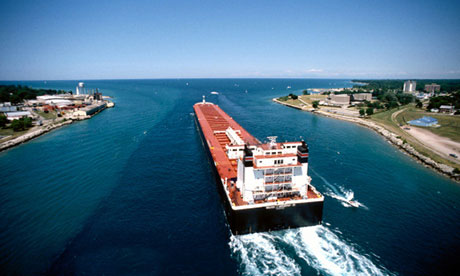Running across the ocean
Rose George started running while on a container ship researching a book. Her crewmates included a homesick lad using exercise as therapy. Did you start in a similarly unlikely environment or was your motivation unusual?


Before boarding the ship, Rose George had barely run in years. Photograph: Robert Ginn/Getty Images
I was a sprinter: 200m was my limit at school sports days, 400m meant gasping. But after school I ran only on a hockey pitch. Then in 2010, at the age of 41, I decided to do two things: first, to go to sea on a container ship for five weeks; second, to learn to run properly. This plan was somewhat flawed. Picture this container ship for a minute: it is a working vessel, the length of three football fields and 10 storeys high. Its decks are covered with stacks of coloured metal containers – "boxes" in industry language. There is no pretty promenade deck, no shuffleboard. There is only metal and water, neither of which are conducive to running.
But I was lucky enough to go to sea on a good ship. Maersk Kendal, operated by the Danish company Maersk (revenues the size of Microsoft, with none of the fame) took its seafarers' welfare seriously enough to provide them with a basketball court on the poop deck (an odd choice, when balls must surely have bounced merrily over the rail into the ocean), a swimming pool (though I never saw it filled), and a gym on B-deck, with several machines, weights, a TV, and in the corner, my salvation. A treadmill.
The gym was in the accommodation house, a block where the Kendal's crew – who number 19, though they had 7,000 boxes to look after – live, rest and work. I learned my bearings in a couple of days: my quarters were on D deck, the bridge was two decks up, food was two below and the gym was one deck further down. I'd loaded Get Running, a couch-to-5K app onto my iPhone before I left – there was no chance of downloading it at sea – and off I went. There was no risk that I would skip a session: I had a lot of downtime, and a lot to run off, such as a stepfather sectioned with violent Alzheimer's, a recent diagnosis of severe endometriosis and a book to write that was going nowhere.
Ship-running also taught me a rare stability, as the monsoon waves of the Indian Ocean sent the gym swaying by about 20 degrees each way. I could always get my sessions in, because the gym wasn't popular. The captain liked to use the rowing machine, but only in the evening when other crew members were not likely to be there. The first officer did some desultory exercises and gladly accepted my yoga DVD because his brother swore yoga had cured his migraines. But there were only three regulars: Julius Jefferson, a muscled able seaman, and the quieter of the two cadets on board, who was training to run a marathon with his dad. I knew when he had been in because the clock was covered with a towel. He wanted to run with his dad, but really he just wanted to be with his dad. As the five weeks passed his quietness magnified, along with his homesickness.
The crew often joked that their job was like being in prison with a salary, although researchers have found that UK prisons provide better facilities than many working ships. So why weren't they in the gym? Because they were too knackered. Modern container ships require a punishing amount of work. A ship needs constant care. Even one carrying as many boxes as Kendal can be in and out of port in only 24 hours. Seafarers barely have time to get ashore for a paper, let alone a long run. When a fitnesstrainer embarked at Rotterdam for four days, there was a flurry of gym attendance, but once the trainer departed, so did the enthusiasm.
So Julius, the quiet cadet and I carried on, and I completed week five of couch to 5K. I disembarked at Singapore, having gone through pirate waters, monsoon weather and 9,288 nautical miles of ocean. Did I go running immediately around a Singaporean park? No, because I was too sad at leaving the ship, and because I'd got mentally stuck on the treadmill. It took me another year to discover outdoor running, collect a daft number of running shoes and learn to love mud. I picture the cadet, though, still somewhere running on a swaying ship, a towel-covered clock on the wall, dreaming of home, and of grass.
• Deep Sea and Foreign Going: Inside Shipping, the Invisible Industry that brings You 90% of Everything, by Portobello Books, is published on 12 September.
Source: The Guardian/BBC, UK.
No comments:
Post a Comment